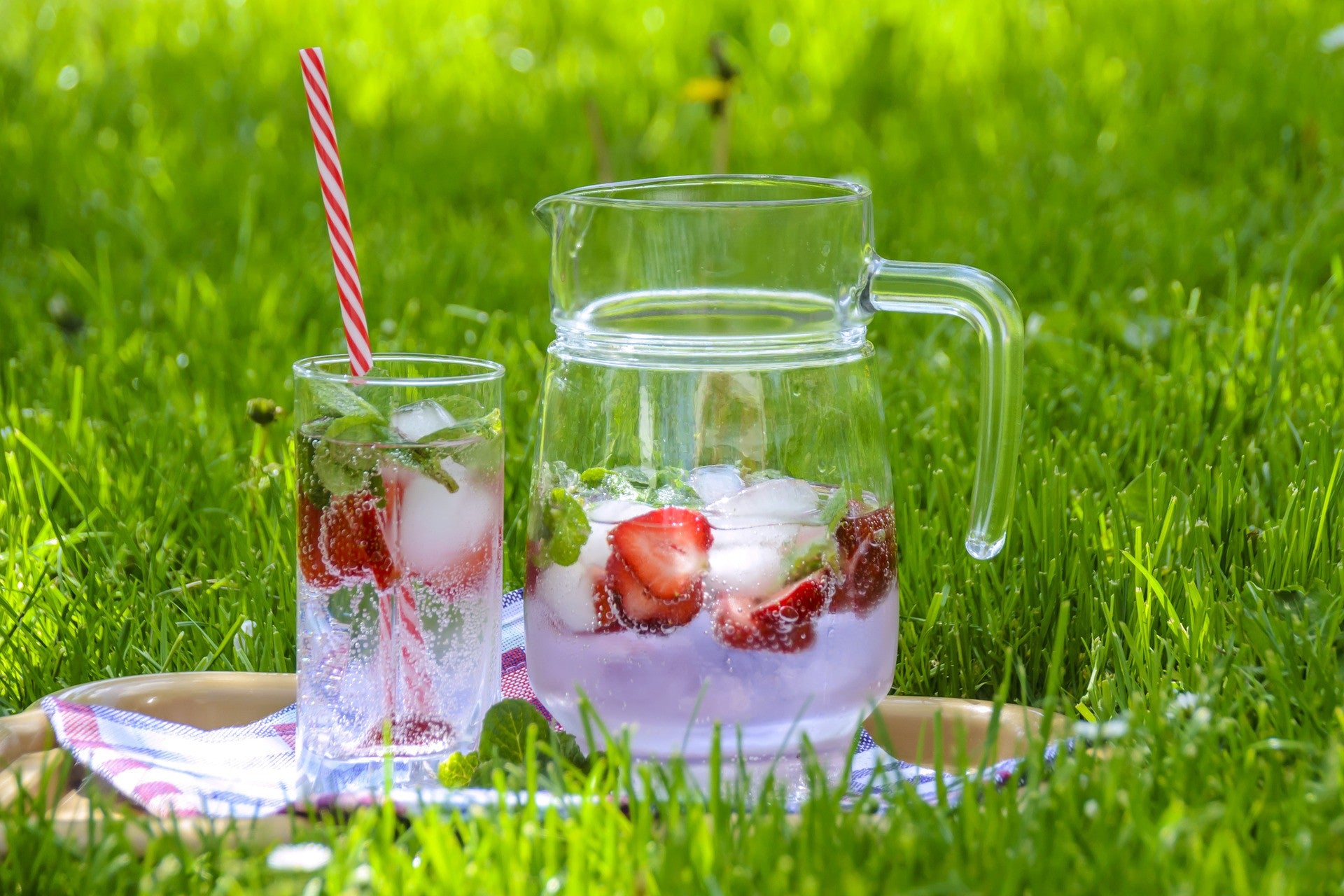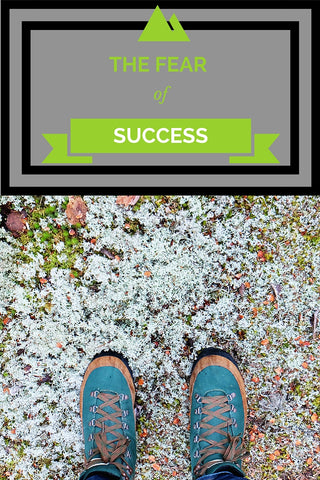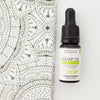Living Well

Infused Water: Make Your H2O More Interesting 0

As we know, drinking enough water is crucial to your diet. Many typically go by the “8x8” rule, meaning you should be drinking 8 8oz glasses of water a day. However, water can get pretty boring, making it easy to reach for some juice or a soft drink. But those choices won’t give you the hydration you need, and have a ton of added sugars and preservatives. Why not try and make your water a little bit more interesting so you can reap all the health benefits without sacrificing taste?
You may think fruit infused water is similar to fruit juice, but infused water is actually a better alternative. Infused water has far less calories, because you are not actually consuming the fruit but you still get the benefits of the taste, leaving you with only a small fraction of the calories. You will also ingest only a small fraction of the sugar you would get from the actual fruit, as it remains intact in the water without being consumed. Water is also as hydrating as it gets. You can drink all the juice you want, but you’ll still need to drink water throughout the day in order to stay hydrated.
Infused water is super easy to make, and it can easily find its way into your daily stops for refreshment without taking up any extra time.
Here are some simple recipes to get you started on the infused water track!
- Mint & Lemon Infused Water
These are two of the best ingredients you can have. Mint is a great blood cleanser and digestive aid, and lemon will cleanse your liver and balance your body’s pH while assisting in weight loss.
For a pitcher of this, you’ll need 1 lemon, thinly sliced, and a few sprigs of mint. You can vary based on how much you want to taste each ingredient! Mix together and let chill for two hours.
- Grapefruit & Rosemary Infused Water
Who said you can only infuse with fruit? Rosemary, paired with grapefruit, will add a unique tinge in which both actually complement the other. Grapefruit is a huge proponent of vitamin C, and can also assist in lowering cholesterol and controlling your insulin levels. Rosemary boosts your immunity and circulation, and can also relieve headaches and improve your mood.
For one pitcher, all you need is 1 grapefruit and 1 sprig of fresh rosemary. Remove your rind and cut the grapefruit into slices. Make sure to put the fruit into the water, as opposed to pouring the water over the fruit, because this leads to floaters. Infuse for 2 hours at room temperature. You may also want to remove the rosemary at 4 hours as to not overpower the grapefruit.
- Apple Cinnamon Infused Water
This flavorful drink will make you feel like fall is here at any time of the year. Apples and cinnamon both help to regulate blood sugar, which is ideal for weight loss. Apples also help to improve beneficial bacteria in the large intestine while cinnamon has been known to improve concentration.
For this recipe, you’ll need ¼ thinly sliced red apple, and 1 cinnamon stick. Cover these ingredients with cold water to keep from the apple browning, and put into the fridge for anywhere from 4 to 24 hours. The longer you infuse, the more apple you’ll taste as they take a little bit longer to release flavor than most fruits.
- Austin Peterson

Vegan vs. Vegetarian 0

These days we hear about a huge assortment of diets--raw, paleo, primal, etc.; it’s easy to get confused or assume they’re all variations of the same thing. There are many factors that can lead people to switch to a diet like this, whether its for a lifestyle change, health reasons, or ethical reasons, but changing your diet can be the first step to changing your life for the better.
The two most popular diets today are vegan and vegetarian, with over 7 million people falling into these categories. We hear a lot about vegan or vegetarian diets or lifestyles in the media, but there’s still a lot of confusion about what really defines each one. Let’s look at each individually, and see if you can determine whether this is a lifestyle change that would benefit you.
By definition, vegetarians avoid eating all animal flesh products. This means any meat, poultry, or fish. Within this group, there are three sub-groups of vegetarians that differ based on their decision to eat cheese or eggs, as they are animal byproducts. Lacto-ovo vegetarians eat dairy and eggs, lacto vegetarians eat dairy but avoid eggs, and vegan vegetarians avoid animal products altogether. Most vegetarians still use animal-derived products in other aspects of life, such as wearing a leather belt or a sweater made of wool. Of course, many vary in how much they adhere to these guidelines based on their own individual perspective.
As we previously stated, vegans are technically a sub-group of vegetarians that adhere to a much stricter diet, but in addition to avoiding food products, they carry the avoidance of using animal-based products into other industries, such as clothing or cosmetics.
Vegan diet restrictions include the exclusion of animal flesh products (meat, poultry, fish), or animal byproducts like eggs, dairy, gelatin or honey. A vegan diet consists of staples like fruits, vegetables, grains, and nuts, with many vegans using tofu as a substitute for meat.
While veganism does refer to diet, many that fall within this group view it instead as a lifestyle.
While some change their diet for health reasons (vegan diets are usually high in fiber and low in fats), the overwhelming majority of those who go vegan do it for moral and ethical reasons. Vegans are against the exploitation of animals for use as food or products by humans, and note the cruelty of the meat, poultry and dairy industries as major factors. Some make this change because of the questions about food safety concerning meat and other animal products, and some also go vegan for environmental or religious reasons.
Vegans also refrain from using any non-food products that come from animals, or are tested on animals. So no leather belts or wool sweaters. If that skin product was tested on animals, it will also be avoided by vegan users.
Vegan and vegetarian food has become much more accessible. In the past most thought of these foods as somewhat boring, plain, and undesirable tasting. Today there are a multitude of options for those that follow these stricter diets that allow people to truly enjoy what they’re eating and get the health benefits they want out of it, with many health food stores specializing in these types of diets. With around 7% of the population identifying as vegan or vegetarian, options are surely growing (and tasting better!)
Some studies even suggest that those who stick to a strict vegan or vegetarian diet may have a lower risk of cancer or heart disease. However, there are some downsides to these diets that you should be aware of when changing your eating habits. Vegan diets often lack essential nutrients that come from meat, and in order for these components to find their way into your diet, you may need to take B12 and amino acid supplements. Vegan diets are also low on iron and vitamin D, and it is necessary to find other sources for your diet.
Some view a vegan or vegetarian diet as the first step to improving your health and adopting a better lifestyle. Both have their benefits and show great health improvements, but we’d recommend consulting a doctor or nutritionist before you decide to switch over!
- Austin Peterson
- Tags: CBD Hemp Oil healthy living nutrition organic vegan vegetarian wellness

Hemp History: Background of the Hemp Plant 0


Hemp has been cultivated for over 10,000 years, making it one of the oldest domesticated crops. It is useful for many purposes, from textiles, to fuel, to food, and now, health supplements. In the 1700s, hemp was such a prosperous farming solution that farmers were often ordered by law to grow it, and by 1850 there were 8,400 documented hemp plantations across the United States. However, hemp’s demise came from its association with marijuana.
Let’s go back first. Hemp is a highly resourceful plant, containing many elements that make it a great source of nutrition. Hemp seeds are high in protein, and have a comparable amino acid profile to food items we consume every day, like milk, meat, eggs, and soy. Hemp seeds are also rich in Vitamin B, manganese, iron, and magnesium. Additionally, hemp is also known for being an excellent source of fiber and many take hemp supplements to add fiber to their diet.
Hemp has been woven for centuries, and has been used to make rope, fabric, or canvas, and there is still a substantial industry for hemp fabric today, especially for those who prefer a natural textile. It has also been used extensively in building materials, even having its own form of concrete, called “hempcrete”.
In the early 1900s, people became uneasy about the usage of hemp because it stems from the same plant as marijuana, Cannabis sativa. Although hemp and marijuana are both of the same species, they are distinct in their strains and have unique biochemical compositions. Marijuana and hemp both contain THC, or tetrahydrocannabinol, which has a psychoactive element that gives users a “high”. However, the different between marijuana and hemp is the potency of THC, as well as the addition of CBD. The most definitive difference between separating hemp and marijuana is its THC content. Hemp has a significantly lower concentration of THC, making it non-psychoactive, and therefore unable to produce any of the side effects that those who are looking to get “high” desire. Many countries draw the line at 0.3% concentration of THC, claiming anything under this amount is considered hemp. In comparison, most medical marijuana strains contain anywhere from 5-20% THC, showing a significant difference between the two. Hemp also contains a high amount of cannabidiol, or CBD, and marijuana does not contain nearly as much. CBD is a non-psychoactive element that actually does the complete opposite; it reduces and counteracts the effect of THC. So essentially, the CBD in hemp can actually eliminate the side effect that come with using marijuana.
Because of its association with marijuana, there is great confusion about what hemp is actually used for, losing a lot of its history along the way. But hemp is actually a highly resourceful plant that is beneficial in many different channels.
- Austin Peterson

6 Things You Should Be Doing to Help Your Body 0
We don’t always have our body’s best interest in mind when going about our lives. But we should take care of our body the way it takes care of us. We sometimes consume foods that aren’t the best for us, enjoy lounging around instead of moving around, and generally deprive our body of things it needs. Here are 6 things you can start doing today to get your body on a healthier track.
- EXERCISE. Let’s start with the most obvious. Exercise is probably the single most beneficial lifestyle change you can make. Of course, it can at times be difficult to start exercising when your body isn’t used to it, but it doesn’t always have to be that way. You can begin to take small steps, such as taking the stairs instead of the escalator (or if you must take the escalator, walk while you move). Exercise doesn’t have to be a chore, either. If the weather is beautiful, take a walk outside while listening to a new album you haven’t gotten a chance to listen to yet, or maybe even a podcast or an audiobook that sparked your interest, in order to keep your mind occupied. Once starting a regular exercise routine, it won’t be long before you start to notice changes in your body and overall health. Cardio is an excellent way to slim down or tone your body by way of burning calories, but there are also many legitimate health benefits you gain by getting that blood pumping, such as reducing the risk of Cardiovascular Disease, Type 2 Diabetes, and Metabolic Syndrome.
Besides the physical element of controlling your weight, exercise is very beneficial for your mental health. Exercising releases endorphins—hormones in the brain associated with positive feelings. Meaning, exercising can also be a natural way to combat depression, which is associated with a low level of endorphins. Ever hear of a “runner’s high?” That’s due to increased endorphin release, in addition to the boost of serotonin—a neurotransmitter in the brain that plays a role in keeping your mood calm. Exercising regularly is also believed to provide you with more energy throughout the day and make you feel more alert and awake.
If you are second-guessing adding exercise to your life, just think of this. Have you ever heard someone say, “I wish I never started exercising, it hasn’t helped me at all”?
- CHOOSE WATER. This one seems like common sense, but you would be surprised to know that most people do not get the daily recommended amount of water. The actual answer varies depending on your gender, age, etc. but the most commonly agreed upon rule is called the 8x8 rule, which states you should drink 8 cups filled with 8oz of water throughout the day, coming to about 2 liters (or half a gallon). This can be made simpler by doing things like carrying a water bottle around with you all day, making it easily accessible whenever your body calls out for refreshment. You can also start substituting any coffee (which is a huge dehydrator) or soft drinks you pair with your meals when out to eat, with a lemon water. This will shed those unnecessary calories from your diet, rehydrate you, and the lemon aids in digestion and detoxification. And, water is free!
Water is necessary to carry out daily bodily functions, remove waste, and carry nutrients and oxygen through our body. Because we lose so much water through functions like urine, bowel movements, perspiration and breathing, it is crucial that we replace what we lose, and then some.
- PICK BRIGHTLY COLORED FOODS. Those eye-catching fruits and vegetables can actually be some of the best for you, with many superfoods being of the bright variety. Aside from looking visually tasty, it is worth noting that brightly colored foods are usually rich in antioxidants, meaning they remove free radicals in your body that are damaging to your cells. Let’s go through the color wheel for some suggestions for your next trip to the grocery store.
Red: These foods are usually high in Lycopene, Ellagic Acid, Quercetin, and Hesperidin. In simpler terms, these are all nutrients that lower your blood pressure, reduce tumor growth, and can support joint tissue for those with arthritis, among other things.
Just a few of the red foods that will nourish your body include: Beets, Cherries, Cranberries, Papaya, Red Apples, Red Grapes, Red Onions, Rhubarb, Tomatoes.
Orange/Yellow: Foods of a yellow or orange shade are usually high in Beta-Carotene, Zeaxanthin, Flavonoids, Lycopene, Potassium, and Vitamin C, which are nutrients that aid in preventing age-related macula degeneration (loss of vision) These nutrients also work together to lower cholesterol and blood pressure, aid in building healthy bones and joints, and promote collagen growth, which are all visible changes you will notice in your body.
Just a few of the orange foods that will get you on the fast-track to a healthy lifestyle are: Apricots, Butternut Squash, Cantaloupe, Carrots, Grapefruit, Peaches, Pumpkin, Sweet Potatoes, Yellow Figs, and Yellow Peppers.
Green: Nutrients frequently found in food of a bright green appearance include Chlorophyll, fiber, lutein, zeaxanthin, calcium, folate, vitamin C, calcium, and Beta-carotene. This group of nutrients is known for various health benefits like lowering blood pressure, improving retinal health, and normalizing digestion, among others.
Types of foods that fall under the green spectrum include: Artichokes, Arugula, Asparagus, Avocado, Green Apples, Green Beans, Pears, Grapes, Honeydew, Kiwi, Leafy Greens, Spinach, and Peas.
Blue/Purple: Lastly we have the final group of colors, which are notably high in Lutein, zeaxanthin, vitamin C, fiber, flavonoids, ellagic acid, and quercetin. These nutrients are essential for retinal health, aid in lowering cholesterol and boosting your immune system, and also fight inflammation and help with digestion.
Types of blue and purple foods that will set you on the path to a nutrient-full lifestyle include: Blackberries, Blueberries, Eggplant, Grapes, Plums, Pomegranates, Prunes, Purple Potatoes, and Purple Cabbage.
- CUT DOWN ON PROCESSED FOODS. Processed foods are a convenience to us when we are looking for a quick meal or we are on the move. Although they may be helpful when we are looking to grab-and-go, the long term effects may be doing your body harm. So what exactly defines a processed food? Lauren Minchen, a registered Dietician and Nutritionist from New York City defines a processed food as “anything edible that no longer looks how it once did in nature, or something that never existed in nature”, adding that these foods are typically riddled with chemicals to preserve them in their packaging; usually jars, boxes, and bags. Most nutritional value is also lost. So, those microwavable meals are probably not the best choice if you are looking to improve your health.
It can be difficult because processed foods are so prominent in our everyday lives; they are essentially everywhere you look: restaurants, grocery stores, snack machines. But if you open your eyes and take some time to seek them out, it can be easy to find “whole food” alternatives. If this seems too intimidating for you, you do not need to completely cut processed foods out of your diet. Going all-natural, all-organic, or vegan can be very challenging to keep up with in our fast-paced lives, so we suggest cutting out one to two processed meals a week and replacing them with something a little better. Then, if you feel like that was too easy, take it a step farther and go from there.
- POSTURE. You might not think this is important to your health, but think again. Posture determines the way we carry ourselves, and many health concerns can appear from incorrectly carrying your weight, from shoulder and back pain, to breathing issues, to even Scoliosis.
Think about this next time you walk. Are your shoulders back or hunched forward, are you standing upright or slouched, is your head held high? You may think these traits are just outwardly physical and they may not matter in the grand scheme of things, but your posture is actually very important in fulfilling some bodily functions.
Good posture actually facilitates better breathing. By standing tall and open, your lungs are actually able to expand and contract much easier, allowing you to take deeper breaths and get an optimum amount of oxygen. Try inhaling while slouched and then do the same while sitting straight. Notice the difference?
The breathing element actually lends itself to concentration and thinking ability. When you breathe properly, you can increase your thinking ability, and sharpen your mind. Because the brain requires 20% of oxygen to function properly, the more oxygen you inhale the more your brain is able to work. Now sit up straight while we give you the last tip of this article!
- JOIN CLASSES. Helping your body doesn’t always have to be physical. Joining a class is something that you can do for yourself that can sometimes tie your physical and mental health together and benefit them both. Joining a class is also a great way to easier implement an idea that we mentioned above into your life! These days, there are classes for everything, and at all levels, which is good, because you’ve got to start somewhere when learning something new!
For exercise purposes, there are an abundance of different classes you can start with. Aerobics classes, Zumba classes, and Spin classes are all hugely popular at most gyms. This is also a great way to meet people that match the skill level of your own, giving you something new to bond over! Outside of the gym, you can try dance classes, like ballet or ballroom, that will slim down your body but also teach you a new skill.
Besides using a class as an exercise method, you can also use classes as a way to improve your mind and happiness, improving your mental health. Some suggested classes to try are art classes or cooking classes to get your creative juices flowing and stimulate your senses. With a cooking class, you can even learn ways to implement more nutritious foods into your diet. Aside from learning a new skill, this is a great way to create a sense of community between you and your peers while exercising your mind, leading to you living a more fulfilled life!- Austin Peterson
The Fear of Success 0

We’ve heard this phrase many times before - so how does this apply to your health and wellness goals? Whether it’s your goal to do one thing - like drink more water, or a more complex one, like lost 30 pounds, we need to realize what it is that might be holding us back in any of these scenarios. Most of the time, we know what we need to do, or we can find out what we need to do, i.e. get the help of a nutritionist. We may think that we simply don’t want it enough, otherwise we would have already done something about it and achieved this goal. However, that’s not the case. Even if you consider yourself a risky person, it can be the fear of taking the risk to achieve your goal and failing. An irrational fear, even, that is holding you back.
What do we mean by this? Well, we know now that simply having a 51% chance or more at succeeding at something is not nearly enough to get us to do it. The odds must be much greater, and when we don’t see the chances as being good, then we’re much less likely to follow that workout plan. Because we have a lot of doubts that it’s not going to work. These may not even be rational - in fact, they are probably irrational fears and reasons as to why we might fail. Nevertheless, they are real to us and keep us from trying to achieve our goals.
The best way to work through this? Help ourselves to realize that the outcomes that can be achieved are worth it to take that risk. This is done by breaking down what we deem to be the risks and what we would like to gain from this experience. Basically, what things are you willing to give up by not achieving your goal and what things you are willing to risk to get there - this can be anything from money, psychological or physical well-being, career, time with family and friends, etc. The point here is to realize your priorities and what matters to you. Plus, taking the time to actually write out or verbalize your fears and possible outcomes may bring you to the realization that this is worth the risk, and sooner than you thought.
- Kate Hurd
- Tags: goals health healthy living live well motivation relaxation success wellness






